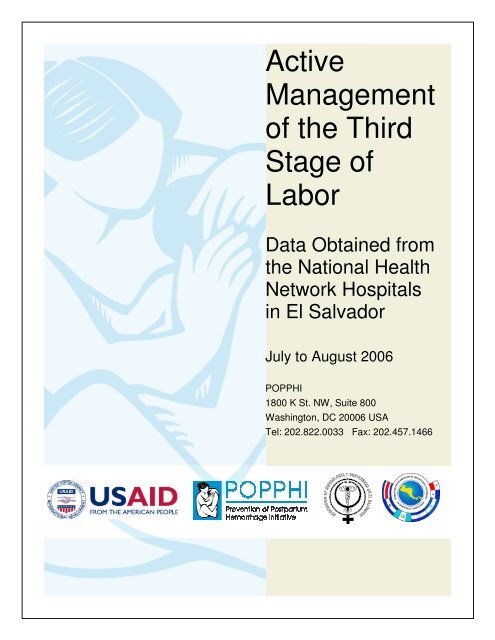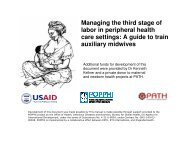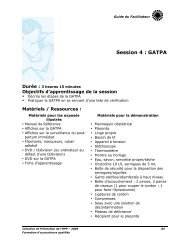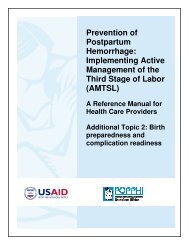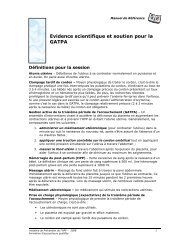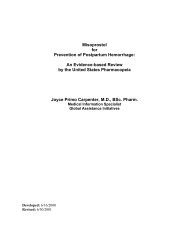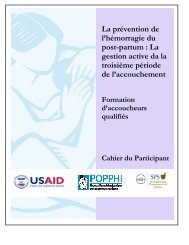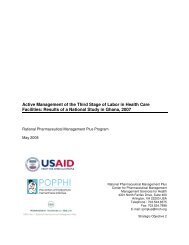El Salvador - Active Management of the Third Stage of Labor - POPPHI
El Salvador - Active Management of the Third Stage of Labor - POPPHI
El Salvador - Active Management of the Third Stage of Labor - POPPHI
Create successful ePaper yourself
Turn your PDF publications into a flip-book with our unique Google optimized e-Paper software.
<strong>Active</strong><strong>Management</strong><strong>of</strong> <strong>the</strong> <strong>Third</strong><strong>Stage</strong> <strong>of</strong><strong>Labor</strong>Data Obtained from<strong>the</strong> National HealthNetwork Hospitalsin <strong>El</strong> <strong>Salvador</strong>July to August 2006<strong>POPPHI</strong>1800 K St. NW, Suite 800Washington, DC 20006 USATel: 202.822.0033 Fax: 202.457.1466
AcknowledgmentsSeveral cooperating agencies and representatives from <strong>the</strong> Office <strong>of</strong> Health, Infectious Diseases,and Nutrition <strong>of</strong> <strong>the</strong> United States Agency for International Development (USAID) havecontributed to this project. The information obtained in this report comes from a study approvedby <strong>the</strong> <strong>El</strong> <strong>Salvador</strong>an Ministry <strong>of</strong> Public Health and does not necessarily represent <strong>of</strong>ficialministry data.The report was prepared by Dr. José Angel Portillo Henriquez, a member <strong>of</strong> <strong>the</strong> Association <strong>of</strong>Gynecology and Obstetrics <strong>of</strong> <strong>El</strong> <strong>Salvador</strong> (ASOGOES) and <strong>the</strong> <strong>El</strong> <strong>Salvador</strong>an coordinatorwithin <strong>the</strong> Research Committee <strong>of</strong> <strong>the</strong> Central American Federation <strong>of</strong> Associations <strong>of</strong>Obstetricians and Gynecologists (COMIN-FECASOG). The country research coordinator wasDr. José Angel Portillo. Data collectors included <strong>the</strong> following nurses: Rut Marlene Bueno,Marlene Ercilla Chiguila, Flor de Maria Guevara Vargas, Yenni <strong>El</strong>izabeth Chavez, Sara RaquelMartinez, Karla Isabel Chavez Pineda, Jenny Flores Sortoñ, and Patricia Maricela Molina.We would like to thank <strong>the</strong> following people and organizations that contributed, in one way orano<strong>the</strong>r, to <strong>the</strong> realization <strong>of</strong> this study. We would like to thank USAID, particularly <strong>the</strong> LatinAmerican and Caribbean Bureau <strong>of</strong> USAID, for its overall support to this study and to <strong>the</strong>Central American region. We would like to thank Deborah Armbruster, Director <strong>of</strong> <strong>the</strong>Prevention <strong>of</strong> Postpartum Hemorrhage Initiative (<strong>POPPHI</strong>) project at PATH for her initiative andcoordination <strong>of</strong> <strong>the</strong> project. We would also like to thank members <strong>of</strong> ASOGOES and its Board <strong>of</strong>Directors for <strong>the</strong> support obtained during <strong>the</strong> development <strong>of</strong> <strong>the</strong> project.We would like to thank <strong>the</strong> support provided by <strong>the</strong> Minister <strong>of</strong> Public Health, Dr. JoséGuillermo Masa Brizuela and Dr. José Ernesto Navarro Marín, Under-Secretary <strong>of</strong> PublicHealth, for authorizing <strong>the</strong> study in 28 maternity hospitals in <strong>the</strong> country, as well as to thank alldirectors, department heads, service managers, medical, and paramedical personnel from <strong>the</strong>National Network Hospitals that participated in <strong>the</strong> project, for <strong>the</strong>ir support and assistance.We would especially like to acknowledge <strong>the</strong> technical support received from <strong>the</strong> Johns HopkinsBloomberg School <strong>of</strong> Public Health, especially to Cynthia Stanton, <strong>the</strong> principal investigator <strong>of</strong><strong>the</strong> global study; research assistants: Hope Johnson, Victor Rhee, Juliana Cuervo, and ManjunathShankar, for <strong>the</strong>ir commendable work; and Rod Knight, <strong>the</strong> sampling and statistical consultantfor <strong>the</strong> project. Lastly, we must acknowledge <strong>the</strong> work carried out by Rebeca Quiroga (<strong>POPPHI</strong>)for her administrative support.This study was funded by USAID, under <strong>the</strong> terms <strong>of</strong> subcontract No. 4-330-0208954, underContract No. GHS-I-00-03-00028.About <strong>POPPHI</strong><strong>POPPHI</strong> is a USAID-funded, five-year project focusing on <strong>the</strong> reduction <strong>of</strong> postpartumhemorrhage, <strong>the</strong> single most important cause <strong>of</strong> maternal deaths worldwide. The <strong>POPPHI</strong> projectis led by PATH and includes four partners: RTI International, EngenderHealth, <strong>the</strong> Internationalii
Federation <strong>of</strong> Gynecology and Obstetrics (FIGO), and <strong>the</strong> International Confederation <strong>of</strong>Midwives (ICM).Commitment to Health: The Central American Federation <strong>of</strong> Associations andSocieties <strong>of</strong> Obstetricians and GynecologistsWe would like to thank <strong>the</strong> Central American Federation <strong>of</strong> Associations and Societies <strong>of</strong>Obstetricians and Gynecologists because it has encouraged each one <strong>of</strong> <strong>the</strong> associations orsocieties to implement projects such as this one through its commitment to reduce maternalmortality at <strong>the</strong> regional level. The Federation <strong>of</strong>fered its support and advice to <strong>the</strong> FederationResearch Committee which consists <strong>of</strong> a country representative from each Association orSociety, and includes: Dr. Douglas Jarquín González, Regional Coordinator; Dr. LigiaAltamirano and Dr. Cesar Augusto Reyes, Regional Sub-coordinators; Dr. Walter LinaresPacheco, Coordinator for Guatemala.; Dr. Jesús Vallecillos Walls, Coordinator for Honduras; Dr.Guillermo Ortiz Avendaño, Coordinator for <strong>El</strong> <strong>Salvador</strong>; Dr. Adolfo Montero Massis,Coordinator for Costa Rica; Dr. Carlos Montufar, Coordinator for Panama; and Dr. Flor MarínCisneros, Coordinator for Nicaragua.Please contact <strong>the</strong> following persons to obtain more information <strong>of</strong> additional copies <strong>of</strong> thisreport:Deborah ArmbrusterProject Director, <strong>POPPHI</strong>PATH1800 K St., NW, Suite 800Washington, DC 20006Tel: 202.822.0033E-mail: darmbruster@path.orgwww.pphprevention.orgDr. Jose Angel Portillo HenriquezMASOGOESRes. Jardines de la cima calle las rosas pte, #5-E San <strong>Salvador</strong> <strong>El</strong> <strong>Salvador</strong>Tel/Fax: (503) 22 481764E-mail: jose.portillo@ads.org.svangelitoebeldeplus@yahoo.comiii
Tables and FiguresFigure 1.1 Determinants <strong>of</strong> <strong>the</strong> routine use <strong>of</strong> AMTSL................................................................................6Table 3.1 Availability and storage conditions for <strong>the</strong> uterotonic drugs at <strong>the</strong> central warehouse ..............12Table 3.2 Percent <strong>of</strong> health facilities with available pharmacies and supplies ...........................................13Table 3.3 Percent <strong>of</strong> facilities procuring oxytocin, ergometrine and misoprostol and percent distribution<strong>of</strong> procured drugs by recommended and observed storage conditions .......................................................14Table 3.4 Percent <strong>of</strong> facilities procuring oxytocin, ergometrine and misoprostol by costs and stock <strong>of</strong>uterotonic drugs ..........................................................................................................................................15Table 4.1 Percent distribution <strong>of</strong> observed deliveries by characteristics <strong>of</strong> <strong>the</strong> health facility and <strong>the</strong>woman.........................................................................................................................................................17Table 4.2 Percent distribution <strong>of</strong> deliveries by correct use <strong>of</strong> oxytocin for AMTSL purposes .................19Table 4.3 Percent distribution <strong>of</strong> observed deliveries by use <strong>of</strong> oxytocin for AMTSL purposes and bycharacteristics <strong>of</strong> <strong>the</strong> facility and woman....................................................................................................21Table 4.4 Percent <strong>of</strong> deliveries with controlled cord traction and uterine massage following delivery <strong>of</strong><strong>the</strong> placenta .................................................................................................................................................22Table 4.5 - Percentage <strong>of</strong> observed deliveries with correct AMTSL use ...................................................23Figure 4.1 Percent <strong>of</strong> deliveries with use <strong>of</strong> a uterotonic drug during <strong>the</strong> third or fourth stage <strong>of</strong> labor,plus additional components <strong>of</strong> AMTSL......................................................................................................24Table 4.6 Percent distribution <strong>of</strong> <strong>the</strong> duration between delivery <strong>of</strong> <strong>the</strong> baby and cord clamping..............24Table 4.7 Average duration <strong>of</strong> <strong>the</strong> third stage <strong>of</strong> labor by AMTSL use ....................................................25Figure 4.2 Percent <strong>of</strong> deliveries with potentially harmful practices ..........................................................26v
AcronymsAMTSL<strong>Active</strong> management <strong>of</strong> <strong>the</strong> third stage <strong>of</strong> laborASOGOES Association <strong>of</strong> Gynecologists and Obstetricians <strong>of</strong> <strong>El</strong> <strong>Salvador</strong>COMIN-FECASOG Committee for Research <strong>of</strong> <strong>the</strong> Central American Federation <strong>of</strong>Gynecology and Obstetric AssociationsFIGOInternational Federation <strong>of</strong> Gynecology and ObstetricsICMInternational Confederation <strong>of</strong> MidwivesIMIntramuscular administrationIVIntravenous administrationMSPASMinistry <strong>of</strong> Public Health and Social Work (Ministerio de Salud Pública yAsistencia Social)<strong>POPPHI</strong>Prevention <strong>of</strong> Postpartum Hemorrhage InitiativeUSAIDUnited States Agency for International DevelopmentWHOWorld Health Organizationvi
Executive SummaryPostpartum hemorrhage is <strong>of</strong> <strong>the</strong> world’s leading causes <strong>of</strong> maternal mortality. <strong>Active</strong>management <strong>of</strong> <strong>the</strong> third stage <strong>of</strong> labor (AMTSL) is a feasible and inexpensive intervention thatcan help save thousands <strong>of</strong> women’s lives. AMTSL involves three basic procedures: <strong>the</strong> use <strong>of</strong> auterotonic agent (preferably oxytocin) within one minute following <strong>the</strong> delivery <strong>of</strong> <strong>the</strong> baby,delivery <strong>of</strong> <strong>the</strong> placenta with controlled cord traction, and massage <strong>of</strong> <strong>the</strong> uterus after delivery <strong>of</strong><strong>the</strong> placenta, with palpation <strong>of</strong> <strong>the</strong> uterus to assess <strong>the</strong> need for continued massage for <strong>the</strong> twohourperiod following delivery <strong>of</strong> <strong>the</strong> placenta. Based on conclusive evidence from clinical trials,<strong>the</strong> International Confederation <strong>of</strong> Midwives (ICM) and <strong>the</strong> International Federation <strong>of</strong>Gynecology and Obstetrics (FIGO) issued a joint statement in 2003 stating that every womanshould be <strong>of</strong>fered AMTSL as a means <strong>of</strong> reducing <strong>the</strong> incidence <strong>of</strong> postpartum hemorrhage. 1 TheWorld Health Organization (WHO) Making Pregnancy Safer Technical Update on Prevention <strong>of</strong>Postpartum Haemorrhage by AMTSL recommends that “AMTSL should be practiced by allskilled attendants at every birth to prevent postpartum haemorrhage.” 2Currently, very little is known about <strong>the</strong> actual practice <strong>of</strong> AMTSL. The aim <strong>of</strong> this study is toprovide ministries <strong>of</strong> health and <strong>the</strong>ir international partners with <strong>the</strong> descriptive informationnecessary to assess AMTSL practices and identify major barriers to its use. Specifically, <strong>the</strong>study asks:1. In what proportion <strong>of</strong> deliveries is AMTSL used nationally?2. What practices are in place that do not conform with <strong>the</strong> FIGO/ICM definition <strong>of</strong> AMTSL?3. What are <strong>the</strong> facility- and policy-level barriers and facilitators to <strong>the</strong> use <strong>of</strong> AMTSL?To answer <strong>the</strong>se questions, a nationally-representative sample <strong>of</strong> facility-based deliveries wasobserved; clinical care guidelines, <strong>the</strong> Essential Drug List, and medical and midwifery schoolcurricula were reviewed; <strong>the</strong> central pharmaceutical storage site, as well as pharmacies in healthfacilities selected for <strong>the</strong> study, were visited; and interviews were conducted with hospitaldirectors and pharmacists.The study showed that only 60 percent <strong>of</strong> <strong>the</strong> deliveries received a uterotonic drug during <strong>the</strong>third or fourth stage <strong>of</strong> labor. The third stage <strong>of</strong> labor begins with <strong>the</strong> birth <strong>of</strong> <strong>the</strong> baby and endswith <strong>the</strong> delivery <strong>of</strong> <strong>the</strong> placenta, and <strong>the</strong> fourth stage <strong>of</strong> labor is <strong>the</strong> first postpartum hour, whichbegins after <strong>the</strong> delivery <strong>of</strong> <strong>the</strong> placenta. Oxytocin, <strong>the</strong> drug <strong>of</strong> choice for AMTSL, was <strong>the</strong> onlyuterotonic drug used. Two AMTSL definitions were used in <strong>the</strong> study. The first definition strictlyreflects <strong>the</strong> FIGO/ICM recommendations, including <strong>the</strong> administration <strong>of</strong> <strong>the</strong> uterotonic drugwithin one minute <strong>of</strong> delivery <strong>of</strong> <strong>the</strong> baby; <strong>the</strong> second definition is slightly more flexible,extending <strong>the</strong> timing <strong>of</strong> <strong>the</strong> uterotonic drug to within three minutes <strong>of</strong> delivery <strong>of</strong> <strong>the</strong> baby. Theresults <strong>of</strong> <strong>the</strong> study show that three percent <strong>of</strong> deliveries met <strong>the</strong> strict definition <strong>of</strong> correctAMTSL use, and seven percent met <strong>the</strong> more relaxed definition <strong>of</strong> AMTSL use. This means thatbetween 93 and 97 percent <strong>of</strong> <strong>the</strong> women delivering in national public health network facilitiesdid not receive adequate prevention <strong>of</strong> postpartum hemorrhage.Several practices led to <strong>the</strong> low use <strong>of</strong> AMTSL. These include <strong>the</strong> incorrect timing <strong>of</strong> <strong>the</strong>administration <strong>of</strong> oxytocin, inappropriate application <strong>of</strong> traction to <strong>the</strong> cord, low use <strong>of</strong> massageimmediately following delivery <strong>of</strong> <strong>the</strong> placenta, and even lower use <strong>of</strong> massage followed by1
palpation to assess <strong>the</strong> need for continued massage. The study also documented severalpotentially harmful practices, such as application <strong>of</strong> traction to <strong>the</strong> cord without prioradministration <strong>of</strong> a uterotonic or without manual support to <strong>the</strong> uterus, and application <strong>of</strong> fundalpressure or uterine massage while awaiting delivery <strong>of</strong> <strong>the</strong> placenta. At least one <strong>of</strong> <strong>the</strong>sepractices was observed in 80 percent <strong>of</strong> deliveries.The policy and logistical environment to support AMTSL use in <strong>El</strong> <strong>Salvador</strong> is mixed. Some keyclinical guidelines for obstetric care promote and define AMTSL using a definition that is closeto <strong>the</strong> FIGO/ICM definition (with <strong>the</strong> exception that palpation <strong>of</strong> <strong>the</strong> uterus to assess need forcontinued massage following delivery <strong>of</strong> <strong>the</strong> baby is not included), while o<strong>the</strong>rs mention only <strong>the</strong>use <strong>of</strong> uterotonics for <strong>the</strong> prevention <strong>of</strong> postpartum hemorrhage. Also, AMTSL is not included in<strong>the</strong> curricula for medical doctors or nurses. However, it should be noted that both oxytocin andergometrine are included on <strong>the</strong> Essential Drug List, oxytocin is clearly <strong>the</strong> uterotonic <strong>of</strong> choicein <strong>El</strong> <strong>Salvador</strong> for AMTSL, and drugs are appropriately stored at <strong>the</strong> Central Warehouse. At <strong>the</strong>facility level, <strong>the</strong> logistics regarding <strong>the</strong> procurement and storage conditions <strong>of</strong> uterotonic drugsin health facilities is quite good, with specific problems in a small percentage <strong>of</strong> facilities, whichrequire attention. For example, oxytocin and ergometrine were observed being stored at roomtemperature in seven and ten percent, respectively, <strong>of</strong> <strong>the</strong> pharmacies <strong>of</strong> visited facilities, and anoverstock <strong>of</strong> uterotonic drugs appears to be more common than understock.RecommendationsThe following recommendations are made based on <strong>the</strong> results <strong>of</strong> this study regarding <strong>the</strong> use <strong>of</strong>AMTSL in <strong>the</strong> national hospital network:National Policies1. Standardize and disseminate <strong>the</strong> use <strong>of</strong> MSPAS National Clinical Care Guidelines for <strong>the</strong>Principal Obstetric Morbidities at <strong>the</strong> Second Level <strong>of</strong> Medical Care (Guias clinicas deatención por las principales morbilidades obstetricas en el segundo nivel de atención) innational public health network hospitals and at private and autonomous health facilities.Ensure that massage/palpation every 15 minutes for two hours is included in <strong>the</strong> AMTSLdefinition.2. Update and disseminate <strong>the</strong> National Clinical Care Guidelines for Obstetric Morbidities at<strong>the</strong> <strong>Third</strong> Level <strong>of</strong> Medical Care (Guias clinicas de las Morbilidades obstetricas en el tercernivel de atención) to comply with <strong>the</strong> FIGO/ICM definition <strong>of</strong> AMTSL.3. Implement <strong>the</strong> FIGO/ICM definition <strong>of</strong> AMTSL into pre-service training programs formedical doctors and nurses as a strategy to decrease morbidity and mortality due topostpartum hemorrhage.4. Work jointly with <strong>the</strong> MSPAS, ASOGOES, international cooperating agencies, and o<strong>the</strong>rorganizations to promote and implement <strong>the</strong> use <strong>of</strong> AMTSL in compliance with <strong>the</strong>definition described in <strong>the</strong> clinical care guidelines for obstetric morbidity at <strong>the</strong> second level<strong>of</strong> medical care .5. Adequately promote and disseminate international standards for <strong>the</strong> appropriate storage <strong>of</strong>uterotonic drugs.2
Facility-level interventionsHealth Providers/Practice6. All medical and paramedical personnel responsible for managing deliveries in <strong>the</strong> 28maternity hospitals should practice AMTSL. This can be accomplished ei<strong>the</strong>r by:a) Conducting hands-on, competency-based, in-service AMTSL training for those providersnot skilled in AMTSL.b) Identifying barriers, including motivation, that impede use <strong>of</strong> AMTSL, and addressbarriers.7. Conduct training for pharmacy personnel regarding <strong>the</strong> appropriate conditions recommendedby <strong>the</strong> manufacturer for storage <strong>of</strong> uterotonic drugs.Logistics and Supplies8. Provide facilities with supplies and equipment needed for <strong>the</strong> appropriate storage <strong>of</strong>uterotonic drugs in pharmacies and delivery rooms.9. Guarantee <strong>the</strong> adequate supply <strong>of</strong> uterotonic drugs in each hospital, avoiding under- andoverstock <strong>of</strong> drugs to ensure that drugs do not pass <strong>the</strong>ir expiration date.Monitoring and Evaluation10. Establish systems <strong>of</strong> supervision within labor and delivery wards such that use <strong>of</strong> AMTSL isan expected behavior in all national public health network birthing facilities.11. Include use <strong>of</strong> AMTSL in <strong>the</strong> routine reporting <strong>of</strong> statistics for national public health networkbirthing facilities for monitoring and control <strong>of</strong> its implementation and use.12. Add a column to <strong>the</strong> registration books <strong>of</strong> <strong>the</strong> delivery rooms for monitoring <strong>the</strong> practice <strong>of</strong>AMTSL.13. Implement clinical audits focused on AMTSL.3
1. BackgroundPostpartum hemorrhage is one <strong>of</strong> <strong>the</strong> world’s leading causes <strong>of</strong> maternal mortality. <strong>Active</strong>management <strong>of</strong> <strong>the</strong> third stage <strong>of</strong> labor (AMTSL) is a feasible and inexpensive intervention thatcan help save thousands <strong>of</strong> women’s lives.AMTSL involves three main components:• The use <strong>of</strong> a uterotonic agent within one minute following <strong>the</strong> birth <strong>of</strong> <strong>the</strong> baby.• Delivery <strong>of</strong> <strong>the</strong> placenta with controlled cord traction.• Massage <strong>of</strong> <strong>the</strong> uterus after delivery <strong>of</strong> <strong>the</strong> placenta.This definition is supported by <strong>the</strong> International Federation <strong>of</strong> Gynecology and Obstetrics(FIGO), <strong>the</strong> International Confederation <strong>of</strong> Midwives (ICM) 1 and <strong>the</strong> World Health Organization(WHO) 2 . This definition differs from <strong>the</strong> original research protocol in <strong>the</strong> Bristol 3 andHinchingbrooke 4 trials because <strong>the</strong> original protocols include immediate cord clamping and didnot include massage <strong>of</strong> <strong>the</strong> uterus. The FIGO/ICM joint statement 1 and Managing Complicationsin Pregnancy and Childbirth, 5 produced by WHO, do not include immediate cord clamping.Clinical trials in developed countries have shown that <strong>the</strong> use <strong>of</strong> AMTSL significantly reducespostpartum hemorrhage, in contrast to physiologic management <strong>of</strong> <strong>the</strong> third stage <strong>of</strong> labor whereoxytocic drugs are not used and <strong>the</strong> placenta separates spontaneously and is delivered by gravityand maternal effort. When compared to AMTSL, <strong>the</strong> use <strong>of</strong> physiologic management has ahigher rate <strong>of</strong> postpartum hemorrhage and severe postpartum hemorrhage, greater need for bloodtransfusion and <strong>the</strong>rapeutic oxytocics, and a longer duration <strong>of</strong> <strong>the</strong> third stage <strong>of</strong> labor. ACochrane review <strong>of</strong> <strong>the</strong>se trials concludes by recommending AMTSL for all women deliveringin a hospital and anticipating <strong>the</strong> vaginal birth <strong>of</strong> a single infant. 6Endorsement and use <strong>of</strong> AMTSLBased on this body <strong>of</strong> evidence, ICM and FIGO issued a joint statement in November 2003stating that every woman should be <strong>of</strong>fered AMTSL “as a means <strong>of</strong> reducing <strong>the</strong> incidence <strong>of</strong>postpartum hemorrhage due to uterine atony.” 1 The inclusion <strong>of</strong> AMTSL in <strong>the</strong> WHO evidencebasedmanual Managing Complications in Pregnancy and Childbirth also attests to <strong>the</strong>international acceptance <strong>of</strong> this practice as <strong>the</strong> standard <strong>of</strong> care. 5Evidence regarding adoption <strong>of</strong> this practice, however, is limited. Evaluations <strong>of</strong> donor-fundedprojects incorporating AMTSL tend to be limited to reporting on <strong>the</strong> numbers <strong>of</strong> providerstrained and <strong>the</strong> percent achieving competence following training. Apart from anecdotalinformation, a 2003 article by <strong>the</strong> Global Network for Perinatal and Reproductive Health (Festinet al.) 7 <strong>of</strong>fers a limited glimpse into <strong>the</strong> adoption <strong>of</strong> this practice. Their results, based on anevaluation <strong>of</strong> 15 university-based referral obstetric centers in developed and developingcountries, show substantial variation between and within hospitals. Overall, only 25 percent <strong>of</strong>observed deliveries included AMTSL. Only one (in Dublin, Ireland) consistently used all threecomponents <strong>of</strong> <strong>the</strong> practice. Variation in <strong>the</strong> prophylactic use <strong>of</strong> oxytocic drugs ranged from 0 to100 percent; <strong>the</strong> practice <strong>of</strong> controlled cord traction ranged from 13 to 100 percent; and <strong>the</strong>number <strong>of</strong> women who received additional doses <strong>of</strong> oxytocin during <strong>the</strong> third stage <strong>of</strong> labor4
anged from 5 to 100 percent. There is insufficient evidence for drawing conclusions about <strong>the</strong>effectiveness <strong>of</strong> this practice in its altered states. These results do suggest, however, that <strong>the</strong> use<strong>of</strong> AMTSL is quite low and, where it is practiced, <strong>the</strong> definition varies within and betweencountries. 7Since 1997, <strong>the</strong> Safe Mo<strong>the</strong>rhood Initiative has stated that maternal mortality is an issue <strong>of</strong> healthinfrastructure. AMTSL is a highly measurable, evidence-based, life-saving aspect <strong>of</strong> this healthinfrastructure. Given that postpartum hemorrhage is a leading cause <strong>of</strong> maternal death in manycountries with high maternal mortality, <strong>the</strong>re is an important and urgent need for informationfrom <strong>the</strong>se countries on current practices regarding AMTSL.About this studyAs a complement to work undertaken by <strong>the</strong> Global Network for Perinatal and ReproductiveHealth, <strong>the</strong>se surveys have been carried out to advance <strong>the</strong> understanding <strong>of</strong> current AMTSLpractices in East and West Africa (Ethiopia, Tanzania, and Benin), Asia (Indonesia), and CentralAmerica (<strong>El</strong> <strong>Salvador</strong>, Guatemala, Honduras, and Nicaragua). Surveys are underway in Ugandaand Ghana. This report focuses on <strong>El</strong> <strong>Salvador</strong>, where maternal mortality was estimated at 71 per100,000 live births in 2006, according to <strong>the</strong> Maternal Mortality Baseline Study, 8 ,withhypertensive disease <strong>of</strong> pregnancy and hemorrhage as <strong>the</strong> two leading causes <strong>of</strong> maternal death(representing 42 percent and 38 percent <strong>of</strong> all maternal deaths, respectively). As <strong>of</strong> 2003, <strong>the</strong>percent <strong>of</strong> births delivered in public health facilities was 54 percent, 12 percent were in socialsecurity facilities, and only three percent occurred in private sector institutions, 9 suggesting thatmore than two-thirds <strong>of</strong> births that take place in facilities could potentially benefit fromAMTSL.The ten country AMTSL surveys focus on policy, provider-related factors, and supplies andlogistics. When viewed toge<strong>the</strong>r, <strong>the</strong>se components provide important insights on routine use <strong>of</strong>AMTSL (Figure 1.1).PolicyAt <strong>the</strong> national level, a number <strong>of</strong> influences determine <strong>the</strong> priority given to AMTSL. Forexample, given that AMTSL has been a standard <strong>of</strong> care in <strong>the</strong> United Kingdom (UK) for manyyears, some researchers have hypo<strong>the</strong>sized that AMTSL is more common in former UK coloniesand among providers who have trained in <strong>the</strong> UK. Likewise, effective leaders from national orinternational agencies may have been able to influence national policies, <strong>the</strong> inclusion <strong>of</strong> drugs in<strong>the</strong> essential drug list and country formulary, and health provider education regarding AMTSL.In turn, such training may influence facility-based policies and behavioral expectations.Provider-related factorsThe knowledge and skills required to perform AMTSL are essential for routine use <strong>of</strong> <strong>the</strong>practice. Provider motivation, which is influenced by facility-based behavioral expectations, alsois key.5
Supplies and logisticsThe sufficient availability <strong>of</strong> high-quality uterotonic drugs, needles, and syringes at national andlocal levels is essential for routine use <strong>of</strong> AMTSL. Effective use <strong>of</strong> AMTSL also requiresappropriate conditions during transport and storage to ensure <strong>the</strong> use <strong>of</strong> chemically-active drugsand safe, sterile needles and syringes.Figure 1.1. Determinants <strong>of</strong> <strong>the</strong> routine use <strong>of</strong> AMTSL.PolicyProviderHistoricalprecedent,influence <strong>of</strong>leader,WHO,in-servicetrainingNationalguidelinesPresence inpre-servicetrainingKnowledge,skills inAMTSLAMTSLprotocolin hospital“Champions” foruse <strong>of</strong> AMTSLMotivationto useExpectedbehaviorin hospitalImplementationProperstorageWomanreceivesAMTSLLogisticsUterotonicsincluded onEssentialDrug List(oxytocin=drug <strong>of</strong>choice)SufficientamountprocuredTransportissuesProcurementat hospitallevelAvailability<strong>of</strong> sufficientoxytocics,needles,syringe on siteThe aim <strong>of</strong> this study is to provide ministries <strong>of</strong> health (MOHs) and <strong>the</strong>ir international partnerswith <strong>the</strong> descriptive information necessary to assess AMTSL practices and identify majorbarriers to its use. The findings will inform interventions that improve adoption andimplementation <strong>of</strong> AMTSL.The study’s specific research questions are as follows:1. For what proportion <strong>of</strong> deliveries is AMTSL used at a national level? Which components <strong>of</strong>AMTSL (e.g., prophylactic use <strong>of</strong> oxytocic agents, controlled cord traction, and fundalmassage) are practiced, and how consistently are <strong>the</strong>y practiced?2. Is AMTSL formally promoted in <strong>the</strong> Standard Treatment Guidelines (STGs) in each countryat national and/or facility levels? If so, since when? How is AMTSL defined in <strong>the</strong>standards?3. How is <strong>the</strong> need for AMTSL drugs quantified at national and facility levels?4. Which uterotonic drug (e.g., oxytocin, ergometrine, or a prostaglandin) is used? How is itstored?5. At <strong>the</strong> facility level, is enough oxytocin available to allow for routine use <strong>of</strong> AMTSL?6
6. What are <strong>the</strong> major barriers to correct use <strong>of</strong> AMTSL, as defined by WHO and FIGO/ICM in<strong>the</strong>ir joint statement on <strong>the</strong> prevention <strong>of</strong> postpartum hemorrhage?7
2. MethodsThis study is part <strong>of</strong> a multiple country study to assess use <strong>of</strong> AMTSL among facility-baseddeliveries. The development <strong>of</strong> <strong>the</strong> study was a participatory process which involved an initialexpert meeting in Washington, DC in May 2005 to elicit feedback on <strong>the</strong> draft protocol, aplanning workshop in Nairobi, Kenya in July 2005 for <strong>the</strong> first two country studies, and planningworkshops in Panama and <strong>El</strong> <strong>Salvador</strong> in January and February 2006 with representatives <strong>of</strong> <strong>the</strong>Central American Federation <strong>of</strong> <strong>the</strong> Associations and Societies <strong>of</strong> Gynecologists andObstetricians (COMIN-FECASOG) to fur<strong>the</strong>r refine <strong>the</strong> protocol and questionnaires before <strong>the</strong>beginning <strong>of</strong> data collection in <strong>El</strong> <strong>Salvador</strong>, Guatemala, Honduras, and Nicaragua.In <strong>the</strong> case <strong>of</strong> <strong>El</strong> <strong>Salvador</strong>, prior to data collection <strong>the</strong> study protocol was submitted to andapproved by <strong>the</strong> Ministry <strong>of</strong> Public Health and Social Work (MSPAS) <strong>of</strong> <strong>El</strong> <strong>Salvador</strong>. Followingthis approval, <strong>the</strong> protocol was submitted to <strong>the</strong> Committee for Human Research at <strong>the</strong> JohnsHopkins Bloomberg School <strong>of</strong> Public Health in Baltimore, Maryland. The Johns HopkinsCommittee for Human Research judged <strong>the</strong> protocol to be exempt from review for humansubjects research because no personal identifiers were collected and because <strong>the</strong> proceduresobserved were all standards <strong>of</strong> care. They did specify that informed consent must be obtained atadmission to <strong>the</strong> health facility and not in <strong>the</strong> labor and delivery room. In this study, informedconsent consisted <strong>of</strong> describing <strong>the</strong> study and requesting participation from women at admissionto <strong>the</strong> health facility. PATH deferred to Johns Hopkins for <strong>the</strong>ir review. The MSPAS did notconsider review by local ethics committees to be necessary.Questionnaire developmentThe processes and outcomes identified in <strong>the</strong> conceptual framework for <strong>the</strong> study (Figure 1.1)determined <strong>the</strong> content and number <strong>of</strong> questionnaires required for <strong>the</strong> study. In all, threequestionnaires were developed:• National-level questionnaire. This questionnaire was designed to capture <strong>the</strong> policyenvironment for AMTSL. It includes questions regarding <strong>the</strong> content <strong>of</strong> <strong>the</strong> essential druglist, STGs, pre-service training curricula, procurement practices for uterotonic drugs, andstorage conditions for uterotonic drugs at <strong>the</strong> central pharmaceutical storage site. Completingthis questionnaire required document review, interviews with MOH staff and o<strong>the</strong>rpolicymakers, and a visit to <strong>the</strong> pharmaceutical storage site. The study’s country coordinatorconducted <strong>the</strong> national-level data collection.• Facility-level questionnaire. This questionnaire was designed to capture <strong>the</strong> policyenvironment at <strong>the</strong> individual facility level. It includes questions on <strong>the</strong> availability <strong>of</strong>clinical guidelines in <strong>the</strong> facility, provision <strong>of</strong> in-service training on AMTSL, <strong>the</strong> cost <strong>of</strong>uterotonic drugs to <strong>the</strong> facility and to patients, access to <strong>the</strong> facility pharmacy, procurementpractices for uterotonic drugs, and supply and storage conditions at <strong>the</strong> facility. Completingthis questionnaire required interviews with hospital administrators and <strong>the</strong> pharmacist and avisit to <strong>the</strong> facility pharmacy. One <strong>of</strong> <strong>the</strong> two members <strong>of</strong> <strong>the</strong> data-collection team completedthis questionnaire during his/her visit to selected facilities.• Observation-<strong>of</strong>-deliveries questionnaire. This questionnaire was designed to documentprovider practices during <strong>the</strong> third stage <strong>of</strong> labor and <strong>the</strong> first 30 minutes <strong>of</strong> <strong>the</strong> fourth stage8
<strong>of</strong> labor for all vaginal deliveries. It was based on <strong>the</strong> questionnaire used in <strong>the</strong> study byFestin et al. 7 The questionnaire documents <strong>the</strong> availability <strong>of</strong> uterotonic drugs and o<strong>the</strong>rsupplies in <strong>the</strong> labor and delivery unit as well as storage conditions for uterotonic drugs.Members <strong>of</strong> <strong>the</strong> data collection team completed <strong>the</strong> questionnaire based on <strong>the</strong>ir observation<strong>of</strong> deliveries during <strong>the</strong> visit to selected facilities.Training for data collectorsA group <strong>of</strong> eight data collectors was trained to observe deliveries in selected health facilities. Theteam was made up <strong>of</strong> eight graduate nurses. The country coordinator and <strong>the</strong> Regionalrepresentative COMIN-FECASOG were in charge <strong>of</strong> observer training. A three-day trainingsession (July 22 to 24, 2006) was held in San <strong>Salvador</strong>, <strong>El</strong> <strong>Salvador</strong>. The training involvedlectures, a visual CD-ROM presentation on AMTSL, demonstrations and practice using ananatomical model, and field practice that provided an opportunity to pretest <strong>the</strong> questionnairesand to supervise <strong>the</strong> observers.Sample DesignA nationally-representative sample <strong>of</strong> approximately 200 facility-based deliveries was requiredto meet <strong>the</strong> aims <strong>of</strong> <strong>the</strong> study described in <strong>the</strong> methodology section. Sample size calculationsassumed a prevalence <strong>of</strong> 30 percent, a 90 percent response rate, and a design effect <strong>of</strong> two. Dueto budgetary and logistical concerns, <strong>the</strong> sample was restricted to public facilities. <strong>El</strong> <strong>Salvador</strong>has 28 national public health maternity hospitals, which are distributed throughout all fiveregions <strong>of</strong> <strong>the</strong> country. All <strong>of</strong> <strong>the</strong>se public maternity hospitals were included in <strong>the</strong> sample.One team <strong>of</strong> two data collectors visited each health facility for two days. Each data collectorobserved all vaginal deliveries during an eight-hour period during <strong>the</strong> first and second day, thusensuring observations over a 16-hour period per day for two days. A total <strong>of</strong> 190 deliveries wereobserved across 28 facilities. In two facilities <strong>the</strong>re were no deliveries during <strong>the</strong> two-day period<strong>of</strong> observation.To ensure a nationally-representative sample <strong>of</strong> deliveries, weights were calculated for useduring analysis. When <strong>the</strong> number <strong>of</strong> deliveries observed in a facility over <strong>the</strong> two-day period isnot proportional to <strong>the</strong> reported annual number <strong>of</strong> deliveries in that facility, weights will correctfor this over- or under-representation. The weighted number <strong>of</strong> observed deliveries is 190. All <strong>of</strong><strong>the</strong> tables in this report show weighted values for n.FieldworkThe MSPAS sent a memorandum to <strong>the</strong> directors <strong>of</strong> <strong>the</strong> 28 hospitals authorizing <strong>the</strong> study. Thestudy coordinator provided a copy <strong>of</strong> <strong>the</strong> memorandum to <strong>the</strong> observers as letters <strong>of</strong> introductionfor each facility. Four teams <strong>of</strong> two data collectors carried out fieldwork from July 28 to August12, 2006. The study coordinator made one quality-control visit to hospitals in each regional zone.9
Data entry and analysisThe study team adapted <strong>the</strong> data entry programs developed for <strong>the</strong> global survey to <strong>the</strong> finalized<strong>El</strong> <strong>Salvador</strong>an questionnaire. EpiInfo (version 3.3.2) was used for data entry and cleaning. Thedata were double entered, and a preliminary data cleaning process was carried out immediatelyfollowing fieldwork. Data cleaning was completed during a data analysis workshop held inBaltimore, MD in December 2006. Data analysis was conducted using STATA 9.1.10
3. ResultsThe National Policy EnvironmentStandard Treatment GuidelinesIn <strong>El</strong> <strong>Salvador</strong>, <strong>the</strong>re are two national guidelines related to maternal health. One is for secondlevelmedical care and <strong>the</strong> o<strong>the</strong>r is for third-level medical care. * AMTSL is mentioned in <strong>the</strong>guidelines entitled, Guías clínicas de atención de las principales morbilidades obstétricas parael Segundo nivel de atención (Clinical Guidelines for <strong>the</strong> principal obstetric morbidities forSecond Level Medical Care) published in 2005. In this document, AMTSL is defined to include:intramuscular administration <strong>of</strong> 10 international units (IU) <strong>of</strong> oxytocin after delivery <strong>of</strong> <strong>the</strong> baby,controlled cord traction with manual support to <strong>the</strong> uterus, and uterine massage after delivery <strong>of</strong><strong>the</strong> placenta. Palpation every 15 minutes for two hours following delivery <strong>of</strong> <strong>the</strong> placenta toassess <strong>the</strong> need for continued massage is not mentioned. Oxytocin is <strong>the</strong> uterotonic drugrecommended for AMTSL use. There is no second choice drug.The use <strong>of</strong> AMTSL is not mentioned in <strong>the</strong> Clinical Care Guidelines for third level medical carethat was published in 2004. In this document, only <strong>the</strong> treatment <strong>of</strong> postpartum hemorrhage isdescribed. However, <strong>the</strong>re are no policies that restrict <strong>the</strong> use <strong>of</strong> AMTSL in <strong>the</strong> country, forexample, by limiting who has <strong>the</strong> authority to use uterotonic drugs.Essential Drug ListBoth oxytocin and ergometrine are registered in <strong>El</strong> <strong>Salvador</strong> and are included as uterotonic drugsin <strong>the</strong> Cuadro Basico de Medicamentos, <strong>the</strong> basic table <strong>of</strong> drugs. Misoprostol, althoughregistered in <strong>the</strong> country, is not included as a uterotonic drug on <strong>the</strong> list. Syntometrine or o<strong>the</strong>rprostaglandins are also not included. The procurement <strong>of</strong> AMTSL drugs in <strong>the</strong> public sector islimited to <strong>the</strong> drugs listed in <strong>the</strong> basic table.Availability and storage <strong>of</strong> uterotonic drugs<strong>El</strong> <strong>Salvador</strong> has a Central Drug Storage and Distribution Warehouse. The Central Warehouseprocures <strong>the</strong> uterotonic drugs included in <strong>the</strong> basic table <strong>of</strong> drugs. The quantity <strong>of</strong> drugs to beprocured is determined by consumption. There was no ergometrine in stock at <strong>the</strong> time <strong>of</strong> <strong>the</strong>visit to <strong>the</strong> Central Warehouse. Oxytocin was available and stored in temperature and lightconditions recommended by <strong>the</strong> manufacturer, that is between 2 to 8° C in <strong>the</strong> dark. According to<strong>the</strong> information obtained, no routine quality-control tests are performed when <strong>the</strong> drugs arereceived at <strong>the</strong> warehouse.*The second level <strong>of</strong> medical care includes all district level hospitals in <strong>the</strong> country. The thirdlevel <strong>of</strong> medical care refers to <strong>the</strong> National Referral Maternity Hospital.11
Table 3.1. Availability and storage conditions for <strong>the</strong> uterotonic drugs at <strong>the</strong> centralwarehouseStorage temperaturerecommended by <strong>the</strong>manufacturerActual storagetemperatureLight conditionsrecommended by <strong>the</strong>manufacturerCurrent light storageconditionsTests done to guarantee<strong>the</strong> quality <strong>of</strong> <strong>the</strong> drugupon receptionHow is quantity <strong>of</strong> drugsdetermined forprocurementOxytocin2-8° C 2-8° CErgometrine2-8° C Not available at <strong>the</strong>time <strong>of</strong> <strong>the</strong> visitStore far away from Store far away fromlightlightStore in <strong>the</strong> darkNoBased onconsumptionNot available at <strong>the</strong>time <strong>of</strong> <strong>the</strong> visitNoBased onconsumptionPre-Service and In-Service Training in AMTSLEven though AMTSL is mentioned in some clinical practice guidelines, it is not currentlyincluded in <strong>the</strong> pre-service curriculum <strong>of</strong> medical doctors or nurses. However, some in-servicetraining programs have been held. This past year, <strong>the</strong> Gerencia de Atención Integral a la Mujer yNiñez (<strong>Management</strong> for Integrated Health Care for Women and Children) <strong>of</strong> <strong>the</strong> MSPAS, withtechnical support from <strong>the</strong> <strong>Salvador</strong>eños Saludables project (SALSA-PRIME II/USAID) <strong>of</strong>fered<strong>the</strong>oretical training on emergency obstetric care for nurses and medical doctors from secondlevelhospitals. Although <strong>the</strong> curricula were not standardized, <strong>the</strong> components <strong>of</strong> AMTSLdescribed above in <strong>the</strong> clinical guidelines for second-level medical care were included in some <strong>of</strong><strong>the</strong> training.The Facility-level Policy EnvironmentFor all health facilities in <strong>the</strong> sample, <strong>the</strong> data collectors interviewed <strong>the</strong> director <strong>of</strong> <strong>the</strong> healthfacility (or o<strong>the</strong>r responsible staff) and <strong>the</strong> pharmacist and visited <strong>the</strong> pharmacy to record <strong>the</strong>availability and storage conditions <strong>of</strong> uterotonic drugs. The results <strong>of</strong> <strong>the</strong>se visits are summarizedbelow.Availability <strong>of</strong> clinical guidelines specific to AMTSLClinical Guidelines mentioning AMTSL were available in all 28 maternity hospitals included in<strong>the</strong> study.12
Table 3.3 Percent <strong>of</strong> facilities procuring oxytocin, ergometrine and misoprostol andpercent distribution <strong>of</strong> procured drugs by recommended and observed storage conditions% <strong>of</strong> facilitiesn = 28Conditions Oxytocin Ergometrine MisoprostolProcured by <strong>the</strong> institution 100.0 75.0 78.6% <strong>of</strong> facilitiesn =28 n =21 n =22Storage temperature recommended by<strong>the</strong> manufacturer2-8 º C 57.1 38.1 0.0
ased on current consumption <strong>of</strong> oxytocin. Given that only 60 percent <strong>of</strong> women receivedoxytocin during <strong>the</strong> third or fourth stages <strong>of</strong> labor, this excess stock should be used to expand <strong>the</strong>use <strong>of</strong> AMTSL for all deliveries. Ergometrine was available at <strong>the</strong> time <strong>of</strong> visit in 90 percent <strong>of</strong><strong>the</strong> facilities, and among <strong>the</strong>se facilities, ten percent had experienced a recent stockout. For fivepercent <strong>of</strong> <strong>the</strong>se facilities, <strong>the</strong> stockout lasted 30 days or longer. One-third <strong>of</strong> <strong>the</strong>se facilities hada stock <strong>of</strong> ergometrine sufficient for greater than 12 months, based on current consumption.Misoprostol is <strong>the</strong> uterotonic drug <strong>the</strong> least available in <strong>El</strong> <strong>Salvador</strong>, with only in 64 percent <strong>of</strong><strong>the</strong> facilities that usually procure it. In more than one-third <strong>of</strong> <strong>the</strong>se facilities (36 percent), <strong>the</strong>rehad been stockouts <strong>of</strong> misprostol during <strong>the</strong> three previous months. Of <strong>the</strong> 22 hospitals thatprocure misoprostol, 27 percent had stock on hand sufficient for longer than 12 months.Table 3.4. Percent <strong>of</strong> facilities procuring oxytocin, ergometrine and misoprostol by costsand stock <strong>of</strong> uterotonic drugs% <strong>of</strong> facilitiesn = 28Conditions Oxytocin Ergometrine MisoprostolProcured by <strong>the</strong> institution 100.0 75.0 78.6% <strong>of</strong> facilitiesn =28 n =21 n =22Availability at <strong>the</strong> time <strong>of</strong> <strong>the</strong> visit 100.0 90.5 63.6How is quantity <strong>of</strong> drug determined forprocurementBased on consumption 96.4 90.4 91.0Standard/fixed quantity3.6 4.8 4.5(determined at <strong>the</strong> central level)No information 0.0 4.8 4.5Facility’s procurement price perampoule/tablet in US$= 7.00 0.0 0.0 18.2No information 7.1 14.3 18.2Months covered with available stockNone available at visit 0.0 0.0 36.4< 1 Month 21.4 9.5 0.01-
0 100.0 90.4 63.6
4. Findings regarding <strong>the</strong> management <strong>of</strong> <strong>the</strong> third stage <strong>of</strong> laborThe principle objectives <strong>of</strong> this study were to measure <strong>the</strong> use <strong>of</strong> AMTSL according toFIGO/ICM criteria and to measure current practices regarding <strong>the</strong> management <strong>of</strong> <strong>the</strong> third andfourth stages <strong>of</strong> labor outside <strong>of</strong> this definition. This section describes <strong>the</strong> management <strong>of</strong> <strong>the</strong>third and fourth stages <strong>of</strong> labor by focusing on 1) <strong>the</strong> overall use <strong>of</strong> uterotonic drugs; 2) <strong>the</strong>timing, mode <strong>of</strong> administration, and dose <strong>of</strong> <strong>the</strong>se drugs; 3) <strong>the</strong> practice <strong>of</strong> <strong>the</strong> individualcomponents <strong>of</strong> AMTSL; 4) <strong>the</strong> correct use <strong>of</strong> AMTSL; and 5) <strong>the</strong> observation <strong>of</strong> potentiallyharmfulpractices.Description <strong>of</strong> <strong>the</strong> study sampleA total <strong>of</strong> 190 deliveries were observed in 26 maternity hospitals in this study. There were nodeliveries during <strong>the</strong> observation period in two hospitals. The weighted number <strong>of</strong> observeddeliveries is 190.Deliveries were observed in all regions <strong>of</strong> <strong>El</strong> <strong>Salvador</strong>, with 31 percent in <strong>the</strong> Oriental region, 25percent in <strong>the</strong> Occidental region and between 13 and 16 percent from o<strong>the</strong>r three regions. SeeTable 4.1. The large majority <strong>of</strong> observed deliveries took place in district hospitals (81 percent),with approximately one-fifth (17 percent) in regional hospitals and only two percent from <strong>the</strong>central referral hospital. All <strong>of</strong> <strong>the</strong> hospitals in <strong>the</strong> sample are located in urban areas. Ninety-fivepercent <strong>of</strong> observed deliveries were in facilities that handle 1,000 or more deliveries per year.Three-quarters <strong>of</strong> <strong>the</strong> observed deliveries were attended by general practitioners or residentdoctors, with six percent attended by an obstetrician. Interns were responsible for 18 percentobserved deliveries. In <strong>the</strong>se hospitals, nurses attended only two percent <strong>of</strong> observed deliveries.The observed deliveries were mainly among young women between 20 and 29 years old (66percent). Thirty percent <strong>of</strong> <strong>the</strong> deliveries were first deliveries. Only seven percent <strong>of</strong> <strong>the</strong>deliveries were to high parity women with four or more births. All <strong>of</strong> <strong>the</strong> deliveries were singlevaginal deliveries.In 42 percent <strong>of</strong> <strong>the</strong> deliveries, <strong>the</strong> women had received a uterotonic drug before <strong>the</strong> third stage<strong>of</strong> labor. Ten percent were induced, 19 percent augmented, and 13 percent were both inducedand augmented. In only 60 percent <strong>of</strong> deliveries did women receive a uterotonic drug during <strong>the</strong>third or fourth stages <strong>of</strong> labor. In all cases, oxytocin was <strong>the</strong> uterotonic drug used.Table 4.1 Percent distribution <strong>of</strong> observed deliveries by characteristics <strong>of</strong> <strong>the</strong> health facilityand <strong>the</strong> womanCharacteristics <strong>of</strong> <strong>the</strong>facility% <strong>of</strong>deliveriesn <strong>of</strong>deliveriesCharacteristics <strong>of</strong> <strong>the</strong>woman% <strong>of</strong>deliveriesn <strong>of</strong>deliveriesRegionAge <strong>of</strong> womanMetropolitan 15.1 29
Central 12.5 24 ParityParacentral 16.1 31 0 30.5 58Area 1 38.4 73Urban 100.0 192 2-3 24.2 46Rural 0.0 0 ≥4 6.8 13Type <strong>of</strong> facilityType <strong>of</strong> deliveryCentral referral 2.1 4 Simple 100.0 190Regional 17.2 33 Multiple 0.0 0District 80.7 155 Use <strong>of</strong> uterotonicdrugs before <strong>the</strong> 3 rdstageAnnual number <strong>of</strong>Induction only 10.0 19deliveries
delivery <strong>of</strong> <strong>the</strong> placenta, followed by palpation <strong>of</strong> <strong>the</strong> uterus every 15 minutes for <strong>the</strong> first 30minutes after delivery <strong>of</strong> <strong>the</strong> placenta.We also present results using a less restrictive definition <strong>of</strong> AMTSL. This second definition <strong>of</strong>AMTSL is exactly <strong>the</strong> same as <strong>the</strong> first definition above, only <strong>the</strong> timing <strong>of</strong> <strong>the</strong> administration <strong>of</strong><strong>the</strong> uterotonic drug is extended to within three minutes <strong>of</strong> <strong>the</strong> delivery <strong>of</strong> <strong>the</strong> baby.Correct use <strong>of</strong> uterotonic drugs for AMTSLThe first component <strong>of</strong> AMTSL is <strong>the</strong> correct use <strong>of</strong> uterotonic drugs. Four criteria must be metfor <strong>the</strong> correct use <strong>of</strong> a uterotonic drug. These are:1. Correct mode <strong>of</strong> administration: <strong>the</strong> uterotonic drug should be administered IM. If <strong>the</strong>woman has been induced or augmented, administration via IM injection, intravenous drip, orintravenous push are all considered correct.2. Correct dose: 10 IU <strong>of</strong> oxytocin or 0.2 mg <strong>of</strong> ergometrine.3. Correct stage <strong>of</strong> labor: uterotonic is to be administered following <strong>the</strong> delivery <strong>of</strong> <strong>the</strong> baby andbefore <strong>the</strong> delivery <strong>of</strong> <strong>the</strong> placenta.4. Correct timing: uterotonic is to be administered within one minute following <strong>the</strong> delivery <strong>of</strong><strong>the</strong> baby (or within three minutes for <strong>the</strong> less restrictive definition used for this study).Table 4.2 presents <strong>the</strong> percentages <strong>of</strong> observed deliveries in which uterotonics were correctlyused. Two points should be noted:1) oxytocin was <strong>the</strong> only uterotonic drug used across <strong>the</strong> entire sample <strong>of</strong> observeddeliveries; no o<strong>the</strong>r drug such as ergometrine, misoprostol, or prostaglandins were used2) oxytocin was administered during <strong>the</strong> third or fourth stage <strong>of</strong> labor in only 60 percent<strong>of</strong> observed deliveries.Among all observed deliveries, oxytocin was correctly used for AMTSL purposes in only 14percent <strong>of</strong> deliveries, that is, <strong>the</strong> drug was correctly administered, <strong>the</strong> dose was correct forAMTSL purposes, <strong>the</strong> drug was given at <strong>the</strong> appropriate stage <strong>of</strong> labor and was given within oneminute or less <strong>of</strong> <strong>the</strong> delivery <strong>of</strong> <strong>the</strong> baby. This percentage increases to 35 percent when <strong>the</strong>timing <strong>of</strong> <strong>the</strong> uterotonic is relaxed to within three minutes. The practices that lead to lowercorrect use <strong>of</strong> oxytocin are: administration <strong>of</strong> <strong>the</strong> drug at <strong>the</strong> incorrect stage <strong>of</strong> labor (15 percent,with one percent administering oxytocin during delivery <strong>of</strong> <strong>the</strong> baby and 14 percent followingdelivery <strong>of</strong> <strong>the</strong> placenta), 11 percent gave an incorrect dose <strong>of</strong> oxytocin (for AMTSL purposes),and 25 percent administered oxytocin at more than three minutes after <strong>the</strong> delivery <strong>of</strong> <strong>the</strong> baby.Table 4.2. Percent distribution <strong>of</strong> deliveries by correct use <strong>of</strong> oxytocin for AMTSLpurposesComponents <strong>of</strong> <strong>the</strong> use <strong>of</strong> oxytocin forAMTSL purposes% <strong>of</strong>deliveriesn <strong>of</strong>deliveriesUse <strong>of</strong> oxytocin during <strong>the</strong> 3 rd or 4 th stages <strong>of</strong>60.0 114labor(40.8, 76.6)No use <strong>of</strong> a uterotonic during <strong>the</strong> 3 rd or 4 th stages 40.0 76<strong>of</strong> laborCorrect administration <strong>of</strong> oxytocin for 57.4 10919
AMTSL purposesOxytocin IM 44.2 84Oxytocin, by any means among inductions 3.7 7Oxytocin, by any means among augmentations 9.5 18Incorrect administration 2.6 5Not used 40.0 76Correct dose <strong>of</strong> oxytocin for AMTSL48.9 93purposes(31.0, 67.5)10 IU for oxytocin 49.2 93Incorrect dose 10.9 21Not used 40.0 76Administration <strong>of</strong> oxytocin at correct stage <strong>of</strong> 44.8 85labor(26.2,65.0)After delivery <strong>of</strong> <strong>the</strong> baby 44.8 85During delivery <strong>of</strong> <strong>the</strong> baby 1.2 2After delivery <strong>of</strong> <strong>the</strong> placenta 14.0 27Not used 40.0 76Timing in which oxytocin was administered≤1 minute 14.1(7.4, 25.2)>1 and 1 and
(38 versus 30 percent, and <strong>the</strong>se differences are not statistically significant). However, deliveriesin facilities that provided AMTSL training for nurses were significantly more likely to showcorrect use <strong>of</strong> AMTSL than those from facilities without such training (42 versus 16 percent).However, one should remember that nurses were only responsible for attending 2 percent <strong>of</strong>deliveries in this sample. High parity women (women with four or more births) show higherpercentages <strong>of</strong> correct use <strong>of</strong> oxytocin than lower parity women, and <strong>the</strong>se differences arestatistically significant.Table 4.3. Percent distribution <strong>of</strong> observed deliveries by use <strong>of</strong> oxytocin for AMTSLpurposes and by characteristics <strong>of</strong> <strong>the</strong> facility and woman% Correctuse <strong>of</strong>oxytocin(≤3min)Use <strong>of</strong> Oxytocin for AMTSL purposes% <strong>of</strong> deliveries% Incorrect % No Total n <strong>of</strong> p valueCharacteristicuse use % deliveriesTotal 35.3 24.7 40.0 100.0 190Region 0.0023Metropolitan 0.0 0.0 100.0 100.0 29Oriental 53.8 40.0 6.2 100.0 60Occidental 50.7 8.3 41.0 100.0 48Central 42.9 18.4 38.7 100.0 24Paracentral 0.00 51.1 48.9 100.0 28Type <strong>of</strong> facility 0.0590Central Referral 0.0 0.0 100.0 100.0 4Regional 85.1 14.9 0.0 100.0 33District 25.8 27.5 46.7 100.0 153Annual number <strong>of</strong>0.0003deliveries
providerObstetrician 34.4 17.2 48.4 100.0 12General practitioner 27.5 28.2 44.3 100.0 141Intern 67.7 15.1 17.2 100.0 34Nurse 32.8 0.00 67.2 100.0 3Time <strong>of</strong> delivery 0.2478Daytime 39.3 22.7 38.0 100.0 137At night 25.2 29.9 44.9 100.0 53Age <strong>of</strong> woman
With massage immediately after delivery <strong>of</strong> <strong>the</strong>placenta PLUS palpation at least twice during <strong>the</strong>30 minutes following delivery <strong>of</strong> <strong>the</strong> placenta23.5(12.1, 40.6)Use <strong>of</strong> AMTSLThe results <strong>of</strong> this study show that only three percent (95 percent confidence intervals: 0.7 to 9.9percent) <strong>of</strong> public, facility-based deliveries in <strong>El</strong> <strong>Salvador</strong> benefit from AMTSL based on <strong>the</strong>strict definition with administration <strong>of</strong> a uterotonic within one minute <strong>of</strong> delivery <strong>of</strong> <strong>the</strong> baby.This increases to seven percent (95 percent confidence intervals: 2.4 to 18.2 percent) withadministration <strong>of</strong> a uterotonic within three minutes. See Table 4.5.Table 4.5. Percentage <strong>of</strong> observed deliveries with correct AMTSL use% with correctAMTSL use (≤1min)2.6(0.7, 9.9)% with correctAMTSL use (≤3min)6.9(2.4, 18.2)Percentage(95% CI)n <strong>of</strong> deliveries 190 190As a means <strong>of</strong> identifying where efforts are most needed to improve compliance with <strong>the</strong>FIGO/ICM definition <strong>of</strong> AMTSL, Figure 4.1 shows <strong>the</strong> percentage <strong>of</strong> observed deliveries duringwhich a uterotonic was given during <strong>the</strong> third or fourth stage <strong>of</strong> labor in <strong>the</strong> left-most column (60percent). Each column to <strong>the</strong> right shows <strong>the</strong> percentage <strong>of</strong> deliveries having received auterotonic, plus one additional component <strong>of</strong> AMTSL. This figure clearly shows that infrequentadministration <strong>of</strong> a uterotonic during <strong>the</strong> third stage <strong>of</strong> labor, administration <strong>of</strong> <strong>the</strong> uterotonic atgreater than one minute following delivery <strong>of</strong> <strong>the</strong> baby, lack <strong>of</strong> both controlled cord traction andimmediate massage and palpation following delivery <strong>of</strong> <strong>the</strong> placenta are <strong>the</strong> componentsresponsible for <strong>the</strong> very low use <strong>of</strong> AMTSL in <strong>El</strong> <strong>Salvador</strong>an facilities. In short, it is not just onepractice that needs to be emphasized to improve correct use <strong>of</strong> AMTSL.23
Figure 4.1. Percent <strong>of</strong> deliveries with use <strong>of</strong> a uterotonic drug during <strong>the</strong> third or fourthstage <strong>of</strong> labor, plus additional components <strong>of</strong> AMTSL1009080601009080Percent <strong>of</strong> deliveries (%)70605040304514 13.6 13.6706050403020107 62.620100Uterotonicdrug use+ Correctstage+ Correct timing(
Duration <strong>of</strong> <strong>the</strong> third stage <strong>of</strong> laborThe duration <strong>of</strong> <strong>the</strong> third stage <strong>of</strong> labor varies depending on how it is managed. Table 4.7 shows<strong>the</strong> average duration <strong>of</strong> <strong>the</strong> third stage <strong>of</strong> labor by whe<strong>the</strong>r <strong>the</strong> correct use <strong>of</strong> AMTSL waspracticed (using both <strong>the</strong> strict and <strong>the</strong> relaxed definitions regarding timing) and whe<strong>the</strong>r or notoxytocin was administered during <strong>the</strong> third stage <strong>of</strong> labor. When AMTSL was used, <strong>the</strong> averageduration <strong>of</strong> <strong>the</strong> third stage <strong>of</strong> labor was 5.8 minutes (95 percent confidence interval: 5.6 to 6.0)using <strong>the</strong> strict definition and 7.0 minutes (95 percent confidence interval: 6.1 to 8.0) using <strong>the</strong>more relaxed definition. In both cases, <strong>the</strong> third stage was significantly shorter than whenoxytocin was not administered (9.3 minutes on average). When oxytocin was used during <strong>the</strong>third stage but not following <strong>the</strong> definition <strong>of</strong> correct use <strong>of</strong> a uterotonic for AMTSL purposes,<strong>the</strong> average duration <strong>of</strong> <strong>the</strong> third stage was 6.9 minutes (6.1 to 7.9), still significantly shorter thanwhen no uterotonic was used at all.Table 4.7. Average duration <strong>of</strong> <strong>the</strong> third stage <strong>of</strong> labor by AMTSL useAverageAMTSL useduration (inminutes) <strong>of</strong> <strong>the</strong>3 rd stage <strong>of</strong> labor95%confidenceintervaln <strong>of</strong>deliveriesCorrect AMTSL use (≤15.8 (5.6, 6.0) 5minute)Correct AMTSL use ( ≤37.0 (6.1, 8.0) 13minute)O<strong>the</strong>r use <strong>of</strong> oxytocin 6.9 (6.1, 7.9) 109No use <strong>of</strong> oxytocin oro<strong>the</strong>r uterotonic9.3 (8.6, 10.0) 76Potentially-harmful practicesIn addition to documenting AMTSL use, data from this study also identified four practicesconsidered potentially harmful. These practices include <strong>the</strong> application <strong>of</strong> fundal pressure whileawaiting <strong>the</strong> placenta, uterine massage following delivery <strong>of</strong> <strong>the</strong> baby, application <strong>of</strong> cordtraction without previous administration <strong>of</strong> a uterotonic, and application <strong>of</strong> cord traction withoutmanual support <strong>of</strong> <strong>the</strong> uterus. All <strong>of</strong> <strong>the</strong>se practices can increase <strong>the</strong> risk <strong>of</strong> postpartumhemorrhage or cause problems such as uterine inversion. As shown in Figure 4.2, <strong>the</strong>se practicesare very common in <strong>El</strong> <strong>Salvador</strong>an facilities. Four-fifths (80 percent) <strong>of</strong> observed deliveries hadat least one <strong>of</strong> <strong>the</strong>se practices. In 56 and 31 percent <strong>of</strong> deliveries, traction to <strong>the</strong> cord was appliedwithout manual support to <strong>the</strong> uterus or without <strong>the</strong> previous administration <strong>of</strong> a uterotonic drug,respectively. In 29 percent <strong>of</strong> deliveries, uterine massage was applied while awaiting delivery <strong>of</strong><strong>the</strong> placenta, and in 11 percent <strong>of</strong> deliveries, uterine pressure was applied while awaiting delivery<strong>of</strong> <strong>the</strong> placenta. Little variation was seen in <strong>the</strong>se practices across characteristics <strong>of</strong> <strong>the</strong> facilityand <strong>the</strong> woman, and none were statistically significant (data not shown).25
Figure 4.2. Percent <strong>of</strong> deliveries with potentially harmful practices1009080% <strong>of</strong> deliveries8070605040302011293156100Fundal pressureapplied whileawaiting placentaUterine massagewhile awaitingplacentaCord Tractionwithout <strong>the</strong> use <strong>of</strong>uterotonic drugsCord tractionwithout manualsupport <strong>of</strong> <strong>the</strong>uterusAny potentiallyharmful practice26
5. Conclusions and recommendationsThe study documented practices during <strong>the</strong> third or fourth stages <strong>of</strong> labor in a representativesample from facilities in <strong>the</strong> National Health Network <strong>of</strong> <strong>El</strong> <strong>Salvador</strong>. The study showed thatonly 60 percent <strong>of</strong> <strong>the</strong> deliveries received a uterotonic drug during <strong>the</strong> third stage <strong>of</strong> labor.Oxytocin, <strong>the</strong> drug <strong>of</strong> choice for AMTSL, was <strong>the</strong> only uterotonic drug used.Two AMTSL definitions were used in <strong>the</strong> study. The first definition strictly reflects <strong>the</strong>FIGO/ICM recommendations, including administration <strong>of</strong> <strong>the</strong> uterotonic drug within one minute<strong>of</strong> delivery <strong>of</strong> <strong>the</strong> baby; <strong>the</strong> second definition is slightly more flexible, extending <strong>the</strong> timing <strong>of</strong><strong>the</strong> uterotonic drug to within three minutes <strong>of</strong> delivery <strong>of</strong> <strong>the</strong> baby. Three percent <strong>of</strong> <strong>the</strong> observeddeliveries comply with <strong>the</strong> strict definition, and seven percent comply with <strong>the</strong> more relaxeddefinition <strong>of</strong> AMTSL use. This means that between 93 and 97 percent <strong>of</strong> <strong>the</strong> women deliveringvaginally in national public health network facilities did not receive adequate prevention <strong>of</strong>postpartum hemorrhage.Several practices led to <strong>the</strong> low use <strong>of</strong> AMTSL. These include: no use <strong>of</strong> uterotonics during <strong>the</strong>third or fourth stages <strong>of</strong> labor; administration <strong>of</strong> oxytocin following delivery <strong>of</strong> <strong>the</strong> placenta,versus following delivery <strong>of</strong> <strong>the</strong> baby; where oxytocin was administered during <strong>the</strong> third stage <strong>of</strong>labor, administration more than one minute following delivery <strong>of</strong> <strong>the</strong> baby; inappropriateapplication <strong>of</strong> traction to <strong>the</strong> cord (fur<strong>the</strong>r described below); low use <strong>of</strong> massage immediatelyfollowing delivery <strong>of</strong> <strong>the</strong> placenta; and even lower use <strong>of</strong> massage followed by palpation toassess <strong>the</strong> need for continued massage. Even though <strong>the</strong>re is a history <strong>of</strong> in-service training formedical doctors and nurses in maternity hospitals, thorough retraining <strong>of</strong> personnel in AMTSL isclearly needed. Ei<strong>the</strong>r <strong>the</strong> previous training did not provide enough clinical practice to raiseparticipants to levels <strong>of</strong> competency, or <strong>the</strong>re are problems with motivation to practice AMTSL,or both. The answer to this question will help to determine what strategies to use to increase <strong>the</strong>utilization <strong>of</strong> AMTSL in <strong>El</strong> <strong>Salvador</strong>.In addition to measuring <strong>the</strong> use <strong>of</strong> AMTSL, this study also documented four potentially-harmfulpractices. These are: <strong>the</strong> application <strong>of</strong> fundal pressure while awaiting <strong>the</strong> placenta, uterinemassage following delivery <strong>of</strong> <strong>the</strong> baby, application <strong>of</strong> cord traction without previousadministration <strong>of</strong> a uterotonic, and application <strong>of</strong> cord traction without manual support <strong>of</strong> <strong>the</strong>uterus. At least one <strong>of</strong> <strong>the</strong>se practices was observed in 80 percent <strong>of</strong> deliveries. Of particularconcern was <strong>the</strong> application <strong>of</strong> cord traction without previous administration <strong>of</strong> a uterotonic(observed in 31 percent <strong>of</strong> deliveries) and application <strong>of</strong> cord traction without manual support to<strong>the</strong> uterus, which was observed in 56 percent <strong>of</strong> deliveries.The national policy environment for AMTSL is mixed in <strong>El</strong> <strong>Salvador</strong>. Favorable conditionsinclude: one <strong>of</strong> two key clinical guidelines (Guias clinicas de atención por las principalesmorbilidades obstetricas en el segundo nivel de atención ) at <strong>the</strong> national level promote <strong>the</strong> use<strong>of</strong> AMTSL (based on a definition that is similar to that recommended by FIGO/ICM); <strong>the</strong>re areno specific policies that restrict <strong>the</strong> use <strong>of</strong> AMTSL; oxytocin and ergometrine are both in <strong>the</strong>Essential Drug List (<strong>the</strong> basic table <strong>of</strong> drugs); and uterotonic drugs are stored under appropriateconditions in <strong>the</strong> Central Warehouse. On <strong>the</strong> o<strong>the</strong>r hand, <strong>the</strong> o<strong>the</strong>r <strong>of</strong> two key clinical guidelinesat <strong>the</strong> national level mentions only use <strong>of</strong> uterotonics for <strong>the</strong> treatment <strong>of</strong> postpartumhemorrhage. AMTSL is not included in pre-service education for medical doctors or nurses.27
Although <strong>the</strong>re is evidence <strong>of</strong> in-service training in <strong>the</strong> last year that includes AMTSL, in thisstudy <strong>the</strong>re was a significant positive relationship between <strong>the</strong> use <strong>of</strong> AMTSL in facilities withsuch training for nurses but not for doctors. Unfortunately, <strong>the</strong> nurses conduct only a smallpercentage <strong>of</strong> <strong>the</strong> deliveries (though <strong>the</strong>y may conduct more deliveries at lower-level healthfacilities). The high percentage <strong>of</strong> deliveries conducted by general practitioners (and interns)makes it imperative that AMTSL be included in <strong>the</strong>ir pre-service education.Overall, <strong>the</strong> logistics regarding <strong>the</strong> procurement <strong>of</strong> uterotonic drugs and <strong>the</strong> storage conditions <strong>of</strong>those drugs in health facilities is quite good, with specific problems in a small percentage <strong>of</strong>facilities which require attention. For example, oxytocin was available at <strong>the</strong> time <strong>of</strong> visit in allfacilities, <strong>the</strong>re had been no stockouts <strong>of</strong> oxytocin documented during <strong>the</strong> previous three months,and in 86 percent <strong>of</strong> facilities, oxytocin was stored at below 15 º C (with 68 percent stored at 2 to8 º C). However, in seven percent <strong>of</strong> facilities, oxytocin was stored at room temperature, and inseven percent <strong>of</strong> facilities <strong>the</strong>re was a stock <strong>of</strong> oxytocin sufficient for greater than 12 months.Given that only 60 percent <strong>of</strong> deliveries received oxytocin during <strong>the</strong> third or fourth stages <strong>of</strong>labor, this excess stock should be used to expand <strong>the</strong> use <strong>of</strong> AMTSL for all deliveries. Regardingergometrine, 75 percent <strong>of</strong> facilities procure ergometrine, <strong>of</strong> which 90 percent both hadergometrine in stock at <strong>the</strong> time <strong>of</strong> <strong>the</strong> facility visit and reported no stockouts during <strong>the</strong> threeprevious months. In 72 percent <strong>of</strong> <strong>the</strong> facilities that procure ergometrine, <strong>the</strong> drug was stored atbelow 15 º C (with 62 percent stored at 2 to 8 º C). In ten percent <strong>of</strong> <strong>the</strong>se facilities, ergometrine wasstored at room temperature, and in 33 percent <strong>the</strong>re was a stock sufficient for greater than 12months.RecommendationsThe following recommendations are made based on <strong>the</strong> results <strong>of</strong> this study regarding <strong>the</strong> use <strong>of</strong>AMTSL in <strong>the</strong> national hospital network:National Policies1. Standardize and disseminate <strong>the</strong> use <strong>of</strong> MSPAS National Clinical Care Guidelines for <strong>the</strong>Principal Obstetric Morbidities at <strong>the</strong> Second Level <strong>of</strong> Medical Care (Guias clinicas deatención por las principales morbilidades obstetricas en el segundo nivel de atención) innational public health network hospitals and at private and autonomous health facilities.Ensure that massage/palpation every 15 minutes for two hours is included in <strong>the</strong> AMTSLdefinition.2. Update and disseminate <strong>the</strong> National Clinical Care Guidelines for Obstetric Morbidities at<strong>the</strong> <strong>Third</strong> Level <strong>of</strong> Medical Care Guias clinicas de las Morbilidades obstetricas en el tercernivel de atención to comply with <strong>the</strong> FIGO/ICM definition <strong>of</strong> AMTSL.3. Integrate <strong>the</strong> FIGO/ICM definition <strong>of</strong> AMTSL into pre-service training programs for medicaldoctors and nurses as a strategy to decrease morbidity and mortality due to postpartumhemorrhage.4. Work jointly with <strong>the</strong> MSPAS, ASOGOES, international cooperating agencies, and o<strong>the</strong>rorganizations to promote and implement <strong>the</strong> use <strong>of</strong> AMTSL in compliance with <strong>the</strong>28
definition described in <strong>the</strong> clinical care guidelines for obstetric morbidity at <strong>the</strong> second level<strong>of</strong> medical care .5. Adequately promote and disseminate international standards for <strong>the</strong> appropriate storage <strong>of</strong>uterotonic drugs.Facility-level interventionsProviders/Practice6. All medical and paramedical personnel responsible for managing deliveries in <strong>the</strong> 28maternity hospitals should practice AMTSL. This can be accomplished ei<strong>the</strong>r by:a. Conducting hands-on, competency-based in-service AMTSL trainings for thoseproviders not skilled in AMTSL.b. Identifying barriers, including motivation, that impede use <strong>of</strong> AMTSL andaddress <strong>the</strong>se barriers.7. Conduct training for pharmacy personnel regarding <strong>the</strong> appropriate conditions recommendedby <strong>the</strong> manufacturer for storage <strong>of</strong> uterotonic drugs.Logistics and Supplies8. Provide facilities with supplies and equipment needed for <strong>the</strong> appropriate storage <strong>of</strong>uterotonic drugs in pharmacies and delivery rooms.9. Guarantee <strong>the</strong> adequate supply <strong>of</strong> uterotonic drugs in each hospital, avoiding under- andoverstock <strong>of</strong> drugs to ensure that drugs do not pass <strong>the</strong>ir expiration date.Monitoring and Evaluation10. Establish systems <strong>of</strong> supervision within labor and delivery wards such that use <strong>of</strong> AMTSL isan expected behavior in all national public health network facilities that attend deliveries.11. Include use <strong>of</strong> AMTSL in <strong>the</strong> routine reporting <strong>of</strong> statistics for national public health networkbirthing facilities for monitoring and control <strong>of</strong> its implementation and use.12. Add a column to <strong>the</strong> registration books <strong>of</strong> <strong>the</strong> delivery rooms for monitoring <strong>the</strong> practice <strong>of</strong>AMTSL.13. Implement clinical audits focused on AMTSL.29
References1. ICM and FIGO. Joint statement: management <strong>of</strong> <strong>the</strong> third stage <strong>of</strong> labour to preventpostpartum haemorrhage. [joint statement] 2003.2. WHO. MPS Technical Update: Prevention <strong>of</strong> Postpartum Haemorrhage by <strong>Active</strong><strong>Management</strong> <strong>of</strong> <strong>Third</strong> <strong>Stage</strong> <strong>of</strong> Labour. 2006.3. Prendiville WJ, Harding JE, <strong>El</strong>bourne DR, Stirrat GM. The Bristol third stage trial: activeversus physiological management <strong>of</strong> <strong>the</strong> third stage <strong>of</strong> labour. British Medical Journal.1988; 297: 1295–1300.4. Rogers J, Wood J, McCandlish R, Ayers, S, Truesday A, <strong>El</strong>bourne D. <strong>Active</strong> versusexpectant management <strong>of</strong> third stage <strong>of</strong> labour: <strong>the</strong> Hinchingbrooke randomizedcontrolled trial. Lancet. 1998; 351: 693–699.5. World Health Organization. Managing Complications in Pregnancy and Childbirth: AGuide for Midwives and Doctors. Geneva: WHO Department <strong>of</strong> Reproductive Health andResearch, 2000. WHO/RHR/00.7.6. Prendiville WJ, Harding JE, <strong>El</strong>bourne D, McDonald S. <strong>Active</strong> versus expectantmanagement in <strong>the</strong> third stage <strong>of</strong> labour (Cochrane review). The Cochrane Library, 2001.7. Festin MR, Lumbiganon P, Tolosa J, Finney K, Ba-Thike K, Chipato T, et al.International survey on variations in practice <strong>of</strong> <strong>the</strong> management <strong>of</strong> <strong>the</strong> third stage <strong>of</strong>labour. Bulletin <strong>of</strong> <strong>the</strong> World Health Organization. 2003; 81:286–291.8. Ministerio de Salud Pública y Asistencia Social. Estudio de Línea Basal de MortalidadMaterna. San <strong>Salvador</strong>, <strong>El</strong> <strong>Salvador</strong>. 2006.9. Asociación Demográfica <strong>Salvador</strong>eña. Encuesta Nacional de Salud Familiar. San<strong>Salvador</strong>, <strong>El</strong> <strong>Salvador</strong>. 2003.30


